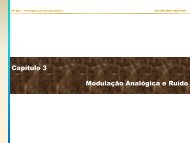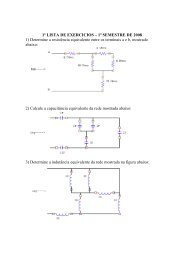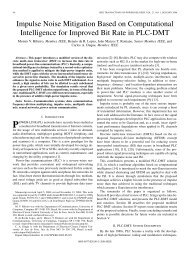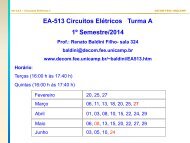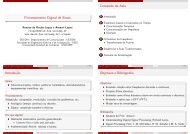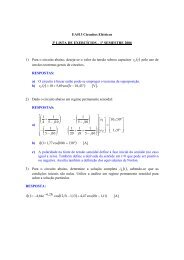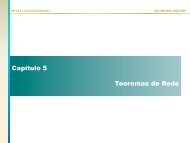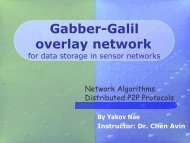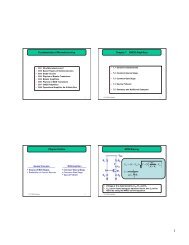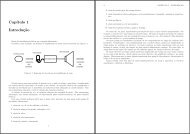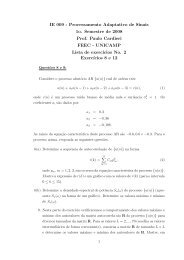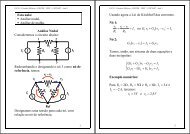Achievable rate region for the Gaussian MIMO MAC with ...
Achievable rate region for the Gaussian MIMO MAC with ...
Achievable rate region for the Gaussian MIMO MAC with ...
You also want an ePaper? Increase the reach of your titles
YUMPU automatically turns print PDFs into web optimized ePapers that Google loves.
G. Fraidenraich and J. PortugheisThe rest of paper is organised as follows. In Section 2,we describe <strong>the</strong> communication system model and makesome definitions. In Section 3, we characterise an achievable<strong>rate</strong> <strong>region</strong> <strong>for</strong> <strong>the</strong> model of Section 2. Then, inSection 4, we give some examples of cooperating systemsand obtain <strong>the</strong>ir achievable <strong>region</strong>s. Finally, in Section 5,we make some final comments and conclusions.2. SYSTEM MODELWe consider a two-user <strong>Gaussian</strong> vector memoryless <strong>MAC</strong>where users can coope<strong>rate</strong> when transmitting <strong>the</strong>ir messages.This is illust<strong>rate</strong>d in Figure 1. The BS receiver hasn r0 antennas, and user i, i D 1; 2, transmits and receives<strong>with</strong> n ti and n ri antennas, respectively.Users 1 and 2 gene<strong>rate</strong> <strong>the</strong>ir messages W 1 and W 2independently and uni<strong>for</strong>mly distributed over <strong>the</strong> setsf1;2;:::;2 NR 1g and f1;2;:::;2 NR 2g. Lety i 2 R nri1 ,i D 0; 1; 2, be <strong>the</strong> received signals at <strong>the</strong> BS, user 1and user 2, respectively. Encoder E i , i D 1; 2, maps<strong>the</strong> message W i and a sequence of previous received signalsy 1 i ; y2 i ;:::;yk i1 into <strong>the</strong> next channel input x k i 2Rn ti, ky 1 0 ; y2 0 ;:::;yN 0D 1;2;:::;N. Upon receiving <strong>the</strong> sequence, <strong>the</strong> BS receiver’s decoder obtains messageestimates OW 1 and OW 2 . An error occurs whenever. OW 1 ; OW 2 / ¤ .W 1 ;W 2 /.A.2 NR 1;2 NR 2;N/code consistsof two sets of N encoding functions and a BS receiver’sdecoding function.The discrete time-invariant channel model is given by(where time index k is dropped)y 0 D H 10 x 1 C H 20 x 2 C z 0 (1)W 1 x 1E 1xx H 12+Ŵ 1W 2z 2H 21z 1H 20H 10z 0+xE 2 xx 2Figure 1. <strong>MIMO</strong> <strong>MAC</strong> cooperation channel model.+Ŵ 2y 1 D H 21 x 2 C z 1 (2)y 2 D H 12 x 1 C z 2 (3)where z i N 0; N i I nri , i D 0; 1; 2, are independentadditive white <strong>Gaussian</strong> noises at <strong>the</strong> BS, user 1 and user2, respectively. The matrix H i0 2 R n r0n ti models <strong>the</strong>channel between user i, i D 1; 2, and <strong>the</strong> BS, whereasmatrices H 12 2 R n r2n t1 and H 21 2 R n r1n t2 model<strong>the</strong> inter-user channels. Each channel matrix is assumedto be known to <strong>the</strong>ir corresponding transmitter andreceiver. Additionally, we assume <strong>the</strong> power constraintstr.E X i X T i / 6 Pi ;i D 1; 2; where EŒ stands <strong>for</strong> <strong>the</strong>average operator, ./ T stands <strong>for</strong> transpose and tr./ is <strong>the</strong>trace operator.The<strong>rate</strong>pair.R 1 ;R 2 / is achievable <strong>for</strong> <strong>the</strong> <strong>Gaussian</strong>vector <strong>MAC</strong> <strong>with</strong> cooperation, if <strong>for</strong> any ">0 and<strong>for</strong> sufficiently large N <strong>the</strong>re exists a sequence of.2 NR 1;2 NR 2;N/ codes such that <strong>the</strong> error probability isless than ". The set of all achievable <strong>rate</strong> pairs is <strong>the</strong>capacity <strong>region</strong> <strong>for</strong> <strong>the</strong> multiple access system describedin this section. In <strong>the</strong> next section, we will characterise anachievable <strong>rate</strong> <strong>region</strong> <strong>for</strong> this system.3. ACHIEVABLE RATE REGIONIn [5], an achievable <strong>rate</strong> <strong>region</strong> <strong>for</strong> <strong>the</strong> discretememoryless <strong>MAC</strong> <strong>with</strong> generalised feedback wasdescribed. As <strong>the</strong> result of [5] is very general, we arguein <strong>the</strong> Appendix A that <strong>the</strong> result of [5] can also be appliedto <strong>the</strong> <strong>Gaussian</strong> vector memoryless <strong>MAC</strong> considered in <strong>the</strong>last section.User 1 divides its message W 1 into two parts, W 10 2f1; 2; : : : ; 2 NR 10g and W 12 2f1;2;:::;2 NR 12g, and<strong>the</strong>nuses signals x 10 2 R n t11 to send <strong>the</strong> first part directly to<strong>the</strong> BS and signals x 12 2 R n r11 to send <strong>the</strong> second partvia user 2.User2 also divides its message in a similar <strong>for</strong>m:W 20 2f1;2;:::;2 NR 20g and W 21 2f1;2;:::;2 NR 21g.Note that R 1 D R 10 C R 12 and R 2 D R 20 C R 21 .User2 has estimated <strong>the</strong> second part of user 1’s message andvice versa. Based on <strong>the</strong>se previous estimated messages,<strong>the</strong>y coope<strong>rate</strong> by simultaneously defining two vectors,u 1 2 R n t11 and u 2 2 R n t21 . We call <strong>the</strong> definition of<strong>the</strong>se vectors as a cooperation st<strong>rate</strong>gy. The users’ signalscan thus be decomposed asx 1 D x 10 C x 12 C u 1 (4)x 2 D x 20 C x 21 C u 2 (5)Now define <strong>the</strong> covariance matrices Q i D E X i X T i ,Q i0 D E X i0 X T i0, QUi D E U i U T i , i D 1; 2, Q12 DE X 12 X T 12and Q21 D E X 21 X T 21. We assume that allvectors x i0 ; u i ;i D 1; 2; x 12 and x 21 have a <strong>Gaussian</strong>distribution. We show in <strong>the</strong> Appendix A that <strong>the</strong> <strong>rate</strong>Trans. Emerging Tel. Tech. (2012) © 2012 John Wiley & Sons, Ltd.DOI: 10.1002/ett
G. Fraidenraich and J. Portugheispair .R 1 ;R 2 / is achievable if <strong>the</strong> inequalities (6)–(11) aresimultaneously satisfied.R 10 6 1 2 log 2 det I n r0C H !10Q 10 H T 10N 0R 20 6 1 2 log 2 det I n r0C H !20Q 20 H T 20N 0Following <strong>the</strong> same reasoning of [8,10], <strong>the</strong> boundary of<strong>the</strong> achievable <strong>rate</strong> <strong>region</strong> can be characterised by solvingR 12 6 1 12 log 2I det nr2 C N 2 I nr2 C H 12 Q 10 H12 T H12 Q 12 H T 12(6)(7)(8)R 21 6 1 12 log 2I det nr1 C N 1 I nr1 C H 21 Q 20 H21 T H21 Q 21 H T 21R 10 C R 20 6 1 2 log 2 det I n r0C H 10Q 10 H T 10 C H !20Q 20 H T 20N 0R 10 C R 12 C R 20 C R 21 6 1 2 log 2 det I nr0 C HQHTN 0(9)(10)(11)In <strong>the</strong>se inequalities,!H D ŒH 10 H 20 and Q DQ 1 Q 3, <strong>with</strong> Q 3 D E U 1 U T 2. Note that matricesQ T 3 Q 2Q 1 and Q 2 can be expressed asQ 1 D Q 10 C Q 12 C Q U1 (12)Q 2 D Q 20 C Q 21 C Q U2 (13)By using Lemma 7.1 of [5], it is possible to show thatan equivalent set of inequalities defining achievable <strong>rate</strong>pairs isR 1 6 F 10 C F 12 (14)R 2 6 F 20 C F 21 (15)R 1 C R 2 6 minf.F 0 C F 12 C F 21 /; F g (16)where F 10 , F 12 , F 20 , F 21 , F 0 and F are <strong>the</strong> righthandsides of inequalities (6), (8), (7), (9), (10) and (11),respectively.Let I 1 D F 10 C F 12 , I 2 D F 20 C F 21 and I 3 Dminf.F 0 C F 12 C F 21 /; F g. We show in Appendix B thatI 3 6 I 1 C I 2 holds true. This implies that <strong>for</strong> a fixed inputQ i0 ;i D 1; 2, Q 12 , Q 21 , and cooperation st<strong>rate</strong>gy Q, <strong>the</strong>achievable <strong>rate</strong> pairs define in general a pentagon. The convexhull of <strong>the</strong> union of all possible pentagons is an achievable<strong>region</strong>. In order to obtain this <strong>region</strong>, a brute-<strong>for</strong>ceapproach is to gene<strong>rate</strong> all pentagons, store <strong>the</strong>ir union and<strong>the</strong>n apply a convex hull algorithm. This may be computationallyhard. An easier way to obtain <strong>the</strong> boundary of<strong>the</strong> <strong>region</strong> is to maximise a weighted sum of <strong>the</strong> <strong>rate</strong>s R 1and R 2 [8, 10], that is, to maximise a 1 R 1 C a 2 R 2 , <strong>with</strong>a 1 C a 2 D 1.<strong>the</strong> following optimisation problem:maxŒ.a 2 a 1 /.F 20 CF 21 /Ca 1 min..F 0 CF 12 CF 21 /; F /(17)subject toQ 10 ; Q 20 ; Q 12 ; Q 21 ; Q U1 ; Q U2 > 0 (18)tr .Q 1 / 6 P 1 (19)tr .Q 2 / 6 P 2 (20)<strong>with</strong> a 1 6 a 2 ;a 1 C a 2 D 1 and Q 3 is a cross-correlationmatrix. A > 0 denotes that A is a positive semi-definitematrix. The <strong>region</strong> obtained using Equation (17) will bedenoted, hereinafter, as <strong>the</strong> achievable <strong>rate</strong> <strong>region</strong>.The functions F 12 , F 21 and F are not concave in <strong>the</strong>space of matrices given in Equation (18), and Q 3 is nota positive semi-definite matrix. Hence, <strong>the</strong> above optimisationproblem is not in <strong>the</strong> class of convex programmingproblems. The MATLAB (MathWorks, Natick, MA, USA)used fmincon <strong>with</strong> a large number of initial conditions scatteredaround <strong>the</strong> domain. After an exhaustive search, wehave chosen <strong>the</strong> best result. Although <strong>the</strong>re is no certaintythat <strong>the</strong> function reaches <strong>the</strong> global solution, <strong>the</strong> appropriatechoice of <strong>the</strong> initial conditions makes it very likely that<strong>the</strong> global solution is found. Indeed, we have comparedsome of <strong>the</strong> results obtained <strong>with</strong> <strong>the</strong> fmincon MATLABcommand to an exhaustive search over a very large set ofcovariance matrices, and we found that <strong>the</strong> final result wasbasically <strong>the</strong> same.Now suppose that we find <strong>the</strong> optimal Q 10 and Q 12that maximise F 10 C F 12 . Then, using matrices Q 10and Q 12 , we find <strong>the</strong> o<strong>the</strong>r optimal st<strong>rate</strong>gies that maximiseEquation (16). This defines an achievable pentagon.Trans. Emerging Tel. Tech. (2012) © 2012 John Wiley & Sons, Ltd.DOI: 10.1002/ett
G. Fraidenraich and J. PortugheisThe same procedure can be carried out to find a secondachievable pentagon by first obtaining Q 20 and Q 21 thatmaximise F 20 C F 21 . And finally, a third pentagon isobtained by maximising Equation (16) and using <strong>the</strong>seoptimal st<strong>rate</strong>gies to find R1 and R 2 . The union of <strong>the</strong>sethree pentagons is achievable. We can enlarge even fur<strong>the</strong>rthis <strong>region</strong> if we allow time sharing combinationof <strong>the</strong> corner points [10, Fig. 5]. This last <strong>region</strong> is alower bound <strong>for</strong> <strong>the</strong> achievable <strong>region</strong> of our <strong>MIMO</strong> <strong>MAC</strong><strong>with</strong> cooperation.In <strong>the</strong> next section, we will show results <strong>for</strong> ourachievable <strong>rate</strong> <strong>region</strong> and <strong>the</strong> lower bound.4. RESULTSWe have obtained results <strong>for</strong> two different systems. In <strong>the</strong>following, all signals x ij and u i are zero mean and unitvariance <strong>Gaussian</strong> variables, respectively.System 1: Consider <strong>the</strong> case where <strong>the</strong> transmitters haveone antenna each and <strong>the</strong> BS has two antennas, that is,n ti D n ri D 1, i D 1; 2, andn r0 D 2. This systemis denoted as system 1 1 2. Setx i0 D p P i0 x i0,i D 1; 2, u 1 D . p P 1 u 1 / and u 2 D p P 2 u 2.Setalso x 12 D p P 12 x 12and x21 D p P 21 x 21. Then,x i D .x i /, i D 1; 2, can be expressed asx 1 D p P 10 x 10 C p P 12 x 12 C p P 1 u 1x 2 D p P 20 x 20 C p P 21 x 21 C p P 2 u 2In <strong>the</strong> superposition block Markov encoding process,cooperation is based on previously estimated messages.This implies that components x ij are independent ofu i ;i D 1; 2. Then, Q 1 D ŒP 10 C P 12 C P 1 ,Q 2 D ŒP 20 C P 21 C P 2 and Q 3 D p P 1 P 2 , <strong>with</strong>jj 6 1.System 2: Consider <strong>the</strong> case where both transmittershave two antennas and <strong>the</strong> BS has four antennas,that is, n ti D n ri D 2, i D 1; 2, and n r0 D 4.This system is denoted as system 2 2 4. Assume<strong>the</strong> following:q q x T i0 D P .1/i0 x.1/ i0 ; P .2/i0 x.2/ i0 ;i D 1; 2q q u T 1 D P .1/1 u 1; P .2/1 u 2q q u T 2 D P .1/2 u 3; P .2/2 u 4q q x T 12 D P .1/12 x.1/ 12 ; P .2/12 x.2/ 12q q x T 21 D P .1/21 x.1/ 21 ; P .2/21 x.2/ 21Then, x T i D .x i1;x i2 /, i D 1; 2, can be expressed asq q qx 11 D P .1/10 x.1/ 10 C P .1/12 x.1/ 12 C P .1/1 u 1q q qx 12 D P .2/10 x.2/ 10 C P .2/12 x.2/ 12 C P .2/1 u 2q q qx 21 D P .1/20 x.1/ 20 C P .1/21 x.1/ 21 C P .1/2 u 3q q qx 22 D P .2/20 x.2/ 20 C P .2/21 x.2/ 21 C P .2/2 u 4Again, <strong>the</strong> components u j , j D 1; 2; 3; 4, are independentof components x .k/ij . Then, Q i , i D 1; 2; 3, aregiven by0BQ 1 D @BC @C0BQ 2 D @qP .1/10 10 P .1/10 P .2/10q 10 P .1/10 P .2/10 P .2/100qP .1/12 12 P .1/12 P .2/12q 12 P .1/12 P .2/12 P .2/1210@ P .1/1 0BC @C0BQ 3 D @0 P .2/1AqP .1/20 20 P .1/20 P .2/20q 20 P .1/20 P .2/20 P .2/200qP .1/21 21 P .1/21 P .2/21q 21 P .1/21 P .2/21 P .2/2110@ P .1/2 00 P .2/2qP .1/1 P .1/2 11qP .2/1 P .1/2 21AqP .1/1 P .2/2 12qP .2/1 P .2/2 221CA C11CA CCA C1CA1CA Cwhere j ij j 6 1 and j ij j 6 1.The achievable <strong>rate</strong> <strong>region</strong> using cooperation has beencompared <strong>with</strong> a non-cooperation case in which <strong>the</strong> capacity<strong>region</strong> is given in [10].Besides <strong>the</strong> non-cooperation case, an outer <strong>region</strong> wasgene<strong>rate</strong>d by maximising <strong>the</strong> three inequalities (14)–(16)independently.The total cooperation line is obtained by evaluating apoint-to-point <strong>MIMO</strong> <strong>with</strong> n r0 receiving and .n t1 C n t2 /transmitting antennas [11].Trans. Emerging Tel. Tech. (2012) © 2012 John Wiley & Sons, Ltd.DOI: 10.1002/ett
G. Fraidenraich and J. PortugheisFigures 2 and 3 show results <strong>for</strong> systems 1 1 2and 2 2 4, respectively. For <strong>the</strong> system of Figure 2,<strong>the</strong> achievable <strong>rate</strong> <strong>region</strong> and <strong>the</strong> lower bound are notshown because <strong>the</strong>y are almost indistinguishable from oneano<strong>the</strong>r and coincide <strong>with</strong> <strong>the</strong> outer <strong>region</strong>. For <strong>the</strong> systemof Figure 3, <strong>the</strong> achievable <strong>rate</strong> <strong>region</strong>, <strong>the</strong> lowerbound, <strong>the</strong> outer <strong>region</strong>, <strong>the</strong> total cooperation line and <strong>the</strong><strong>MIMO</strong> <strong>MAC</strong> <strong>with</strong>out cooperation are shown. Note that <strong>the</strong>achievable <strong>rate</strong> <strong>region</strong> and <strong>the</strong> lower bound are very close,showing <strong>the</strong> tightness of this bound.As can be observed in both figures, cooperation enlargessignificantly <strong>the</strong> <strong>rate</strong> <strong>region</strong>. It is worthwhile to note thatthis enlargement is only possible when <strong>the</strong> inter-user channelmatrices H 12 and H 21 represent better channels than<strong>the</strong> direct links channels H 10 and H 20 . In o<strong>the</strong>r words, <strong>the</strong>users are close to each o<strong>the</strong>r.The point where user 2 acts as a relay to user 1,(R1 ;0), where R 1 is <strong>the</strong> maximum of <strong>the</strong> right-hand sideR232.521.510.5System 2x2x4, P1=2, P2=2Cooperation outer <strong>region</strong>Total Cooperation Line<strong>MIMO</strong> <strong>MAC</strong> <strong>with</strong>out Cooperation<strong>Achievable</strong> <strong>rate</strong> <strong>region</strong>0 0.5 1 1.5 2 2.5R1Figure 4. <strong>Achievable</strong> <strong>rate</strong> <strong>region</strong> <strong>for</strong> a 2 2 4 system<strong>with</strong> H 10 D Œ0:5 0:45I 0:55 0:5I 0:4 0:6I 0:6 0:55; H 20 DŒ0:9 0:89I 0:85 0:95I 0:98 0:94I 0:94 0:97; H 12 D H 21 DŒ0:95 0:93I 0:93 0:99.R21.61.41.210.80.60.40.2System 1x1x2, P1=2, P2=2Cooperation outer <strong>region</strong>Without CooperationTotal Cooperation Lineof Equation (14), is an achievable <strong>rate</strong> <strong>for</strong> a <strong>MIMO</strong> relaychannel [12]. The fact that R 2 D 0 does not mean thatP 2 D 0, because user 2 is cooperating <strong>with</strong> user 1. Asimilar conclusion holds <strong>for</strong> <strong>the</strong> case where user 1 acts as arelaytouser2.In order to illust<strong>rate</strong> a case where <strong>the</strong> direct channelis very dissimilar, Figure 4 shows a <strong>rate</strong> <strong>region</strong> when <strong>the</strong>direct channel of user 2 is stronger than channel of user 1.Note that <strong>the</strong> achievable <strong>rate</strong> <strong>region</strong> and <strong>the</strong> outer <strong>region</strong> arecoincident. Note also that <strong>the</strong> achievable <strong>region</strong> <strong>for</strong> user 1,<strong>the</strong> weak user, has been enlarged considerably.00 0.2 0.4 0.6 0.8 1 1.2 1.4 1.6R1Figure 2. <strong>Achievable</strong> <strong>rate</strong> <strong>region</strong> <strong>for</strong> a 1 1 2system<strong>with</strong>(H 10 D Œ0:65 0:67; H 20 D Œ0:67 0:61; H 12 D H 21 D 0:985).R22.521.510.5System 2x2x4, P1=2, P2=2Cooperation outer <strong>region</strong>Total Cooperation Line<strong>MIMO</strong> <strong>MAC</strong> <strong>with</strong>out Cooperation<strong>Achievable</strong> <strong>rate</strong> <strong>region</strong>Cooperation lower bound00 0.5 1 1.5 2 2.5R1Figure 3. <strong>Achievable</strong> <strong>rate</strong> <strong>region</strong> <strong>for</strong> a 2 2 4 system<strong>with</strong> H 10 D Œ0:5 0:45I 0:55 0:5I 0:4 0:6I 0:6 0:55; H 20 DŒ0:3 0:6I 0:45 0:7I 0:6 0:24I 0:34 0:7; H 12 D H 21 DŒ0:95 0:93I 0:93 0:99.5. CONCLUSIONSAn achievable <strong>rate</strong> <strong>region</strong> <strong>for</strong> <strong>the</strong> two-user <strong>Gaussian</strong> <strong>MIMO</strong><strong>MAC</strong> <strong>with</strong> cooperating encoders was presented. The <strong>region</strong>generally enlarges <strong>the</strong> capacity <strong>region</strong> of a <strong>MIMO</strong> <strong>MAC</strong><strong>with</strong>out cooperation. Although <strong>the</strong> achievable <strong>rate</strong> boundsare described by non-concave functions, <strong>the</strong> boundaryof <strong>the</strong> achievable <strong>rate</strong> <strong>region</strong> could be gene<strong>rate</strong>d bymaximising a weighted sum of <strong>the</strong> <strong>rate</strong>s.APPENDIX AWillems gave in [5, Theorem 7.1, Lemma 7.1] an achievable<strong>rate</strong> <strong>region</strong> <strong>for</strong> a discrete memoryless <strong>MAC</strong> <strong>with</strong>generalised feedback. The achievability proof is basedon superposition block Markov encoding and backwarddecoding. The set of inequalities defining achievable <strong>rate</strong>pairs can be expressed asR 1 6 I.V 1 I Y 2 jX 2 ;U/C I.X 1 I Y jX 2 ;V 1 ;U/ (21)R 2 6 I.V 2 I Y 1 jX 1 ;U/C I.X 2 I Y jX 1 ;V 2 ;U/ (22)Trans. Emerging Tel. Tech. (2012) © 2012 John Wiley & Sons, Ltd.DOI: 10.1002/ett
G. Fraidenraich and J. PortugheisR 1 C R 2 6 min fI .V 1 I Y 2 jX 2 ;U/C I.V 2 I Y 1 jX 1 ;U/C I.X 1 ;X 2 I Y jV 1 ;V 2 ;U/;I.X 1 ;X 2 I Y/g (23)over <strong>the</strong> joint probabilityP.u;v 1 ;v 2 ;x 1 ;x 2 ;y 1 ;y 2 ;y/DD P.u/P.v 1 ju/P .v 2 ju/P .x 1 jv 1 ;u/ P.x 2 jv 2 ; u/P .y; y 1 ;y 2 jx 1 ;x 2 /:By considering an appropriate definition of <strong>the</strong> jointAEP property [13] <strong>for</strong> jointly typical decoding <strong>for</strong>continuous random variables and making <strong>the</strong> substitutions,U .U 1 ; U 2 / U, V 1 X 12 , V 2 X 21 ,X 1 X 1 ,X 2 X 2 , Y 1 Y 1 , Y 2 Y 2and Y Y 0 , inequalities (14), (15) and (16) can bederived. Note that in our case, P.y;y 1 ;y 2 jx 1 ;x 2 / DP.yjx 1 ;x 2 /P .y 1 jx 1 ;x 2 /P .y 2 jx 1 ;x 2 / because of <strong>the</strong>noise independency.For example, <strong>the</strong> first mutual in<strong>for</strong>mation inEquation (14), that is, F 10 , can be evaluated using <strong>the</strong> chainrule asI. X 1 I YjX 2 ; X 12 ; U/ Dh.YjX 2 ; X 12 ; U/ h.YjX 1 ; X 2 ; X 12 ; U/D 1 2 log 2e det N 0 I nr0 C H 10 Q 10 H T 1012 log 2 det e N 0I nr0D 1 2 log 2 det I n r0C H !10Q 10 H T 10N 0All <strong>the</strong> o<strong>the</strong>r evaluations of mutual in<strong>for</strong>mation follow<strong>the</strong> same rationale and will not be shown here.APPENDIX BConsider inequalities (21), (22) and (23). LetI 1 D I.V 1 I Y 2 jX 2 ;U/C I.X 1 I Y jX 2 ;V 1 ;U/I 2 D I.V 2 I Y 1 jX 1 ;U/C I.X 2 I Y jX 1 ;V 2 ;U/I 3 D minfI 3A ;I 3B gD minfI .V 1 I Y 2 jX 2 ;U/C I.V 2 I Y 1 jX 1 ;U/C I.X 1 ;X 2 I Y jV 1 ;V 2 ;U/;I .X 1 ;X 2 I Y/gShowing that I 3 6 I 1 C I 2 is equivalent to showing thatI 3A 6 I 1 C I 2 , which in turn is equivalent to showingthat I.X 1 ;X 2 I Y jV 1 ;V 2 ;U/ 6 I.X 1 I Y jX 2 ;V 1 ;U/ CI.X 2 I Y jX 1 ;V 2 ;U/.Because of <strong>the</strong> independence of .X 1 ;Y/ <strong>with</strong> respectto V 2 and of .X 2 ;Y/ <strong>with</strong> respect to V 1 , we can writethat I.X 1 I Y jX 2 ;V 1 ;U/ D I.X 1 I Y jX 2 ;V 1 ;V 2 ;U/ andI.X 2 I Y jX 1 ;V 2 ;U/ D I.X 2 I Y jX 1 ;V 1 ;V 2 ;U/.However,conditioned on V 1 ;V 2 ,andU , X 2 and X 1 are independent.There<strong>for</strong>e, we can apply <strong>the</strong> same reasoningused in [13] <strong>for</strong> a two-user <strong>MAC</strong> <strong>with</strong>out cooperation, toconclude that I 3 6 I 1 C I 2 .ACKNOWLEDGEMENTSThe authors would like to thank Prof. Paulo A. V. Ferreiraand Prof. Wei Yu <strong>for</strong> <strong>the</strong> helpful discussions.REFERENCES1. Boche H, Jorswieck EA. On <strong>the</strong> per<strong>for</strong>mance optimizationin multiuser <strong>MIMO</strong> systems. European Transactionson Telecommunications 2007; 18(3): 287–304.2. Maric I, Goldsmith A, Kramer G, (Shitz) SS. On <strong>the</strong>capacity of interference channels <strong>with</strong> one cooperatingtransmitter. European Transactions on TelecommunicationsApril 2008; 19(19): 405–420.3. Sendonaris A, Erkip E, Aazhang B. User cooperationdiversity. Part I. System description. IEEE Transactionson Communications November 2003; 51(11):1927–1938.4. Sendonaris A, Erkip E, Aazhang B. User cooperationdiversity—part II: implementation aspects and per<strong>for</strong>manceanalysis. IEEE Transactions on Communications2003; 51: 1939–1948.5. Willems F. In<strong>for</strong>mation <strong>the</strong>oretical results <strong>for</strong> <strong>the</strong> discretememoryless multiple access channel, PhD Thesis,1982. 109–126.6. Kaya O, Ulukus S. Power control <strong>for</strong> fading cooperativemultiple access channels. IEEE Transactions onWireless Communications 2007; 6(8): 2915–2923.7. Edemen C, Kaya O. <strong>Achievable</strong> <strong>rate</strong>s <strong>for</strong> <strong>the</strong> three usercooperative multiple access channel. In IEEE WirelessCommunications and Networking Conference, WCNC2008, 2008; 1507–1512.8. Tse D, Viswanath P. Fundamentals of Wireless Communication.Cambridge University Press Ed. 2004.9. Goldsmith A, Jafar SA, Jindal N, Vishwanath S. Capacitylimits of <strong>MIMO</strong> channels. IEEE Journal on SelectedAreas in Communications 2003; 21(5): 684–702.10. Yu W, Rhee W, Boyd S, Cioffi JM. Iterative waterfilling<strong>for</strong> <strong>Gaussian</strong> vector multiple-access channels.IEEE Transactions on In<strong>for</strong>mation Theory 2004; 50(1):145–152.11. Telatar IE. Capacity of multi-antenna <strong>Gaussian</strong> channels.European Transactions on TelecommunicationsNovember 1999; 10(6): 585–595.12. Wang B, Zhang J, Host-Madsen A. On <strong>the</strong> capacityof <strong>MIMO</strong> relay channels. IEEE Trans. In<strong>for</strong>m. Theory2005; 51(1): 29–43.13. Cover TM, Thomas JA. Elements of In<strong>for</strong>mation Theory.Wiley, Ed. 2006.Trans. Emerging Tel. Tech. (2012) © 2012 John Wiley & Sons, Ltd.DOI: 10.1002/ett



